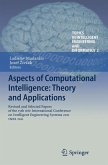This monograph is dedicated to the systematic presentation of main trends, technologies and methods of computational intelligence (CI). The book pays big attention to novel important CI technology- fuzzy logic (FL) systems and fuzzy neural networks (FNN). Different FNN including new class of FNN- cascade neo-fuzzy neural networks are considered and their training algorithms are described and analyzed. The applications of FNN to the forecast in macroeconomics and at stock markets are examined. The book presents the problem of portfolio optimization under uncertainty, the novel theory of fuzzy portfolio optimization free of drawbacks of classical model of Markovitz as well as an application for portfolios optimization at Ukrainian, Russian and American stock exchanges. The book also presents the problem of corporations bankruptcy risk forecasting under incomplete and fuzzy information, as well as new methods based on fuzzy sets theory and fuzzy neural networks and results of their application for bankruptcy risk forecasting are presented and compared with Altman method.
This monograph also focuses on an inductive modeling method of self-organization - the so-called Group Method of Data Handling (GMDH) which enables to construct the structure of forecasting models almost automatically. The results of experimental investigations of GMDH for forecasting at stock exchanges are presented. The final chapters are devoted to theory and applications of evolutionary modeling (EM) and genetic algorithms.
The distinguishing feature of this monograph is a great number of practical examples of CI technologies and methods application for solution of real problems in technology, economy and financial sphere, in particular forecasting, classification, pattern recognition, portfolio optimization, bankruptcy risk prediction under uncertainty which were developed by authors and published in this book for thefirst time. All CI methods and algorithms are presented from the general system approach and analysis of their properties, advantages and drawbacks that enables practitioners to choose the most adequate method for their own problems solution.
This monograph also focuses on an inductive modeling method of self-organization - the so-called Group Method of Data Handling (GMDH) which enables to construct the structure of forecasting models almost automatically. The results of experimental investigations of GMDH for forecasting at stock exchanges are presented. The final chapters are devoted to theory and applications of evolutionary modeling (EM) and genetic algorithms.
The distinguishing feature of this monograph is a great number of practical examples of CI technologies and methods application for solution of real problems in technology, economy and financial sphere, in particular forecasting, classification, pattern recognition, portfolio optimization, bankruptcy risk prediction under uncertainty which were developed by authors and published in this book for thefirst time. All CI methods and algorithms are presented from the general system approach and analysis of their properties, advantages and drawbacks that enables practitioners to choose the most adequate method for their own problems solution.
"The book under review is a well-written volume mainly addressing fuzzy systems. ... The applications explored are geared heavily towards finance, and as such this book is probably a good introduction to CI for a graduate level course in economics, finance or social sciences. ... Overall, this is a nice book, with a refreshing Eastern European style of writing ... ." (Sandro Skansi, Mathematical Reviews, August, 2018)
"The book describes the mathematical equations, inequalities, and functions that can be used to calculate some results and achieve some data analysis objectives. ... The book is interesting for researchers working on economic, financial, and societal phenomena, but it requires a deepunderstanding the underlying mathematical techniques. The book may be useful for researchers of computational intelligence because it contains a comprehensive set of algorithms and their mathematical descriptions." (Bálint Molnár, Computing Reviews, April, 2017)
"The book describes the mathematical equations, inequalities, and functions that can be used to calculate some results and achieve some data analysis objectives. ... The book is interesting for researchers working on economic, financial, and societal phenomena, but it requires a deepunderstanding the underlying mathematical techniques. The book may be useful for researchers of computational intelligence because it contains a comprehensive set of algorithms and their mathematical descriptions." (Bálint Molnár, Computing Reviews, April, 2017)









